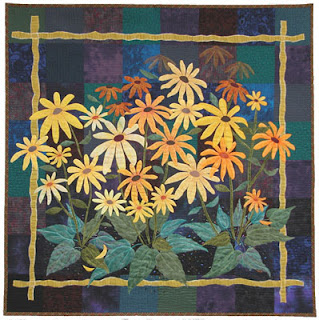 |
| Japanese vase made for export, early 1900's |
This quilt came to life during a teaching trip to
Empty Spools Seminars at Asilomar two years ago. I used a mixture
of flower shapes so each bud and blossom was different. There
are tight buds, an unfurling flower, and 3 gorgeous flower heads, I love the way the flowers turned out. The shape of the flowers was inspired by an old Japanese vase. I traced them off, enlarged them, and simplified some areas to make them easier to applique. I used all the rich royal purple fabrics I could find in my stash. The good thing about the way I work is that I don't need large pieces of fabric for anything except the quilt back. To
applique the long iris leaves I used a scalloped programed stitch on my
machine that gave the edges a different look than anything I had ever done
before.
 |
| Finished Purple Iris Quilt |
During my workshop, I got all the flowers and
leaves cut out and fused onto the background. It made such a beautiful picture that my students
suggested that I made it into a pattern. After I finished the applique work, embroidery and quilting, I prepared
the directions and pattern pieces. I created a terrific pattern cover and was
so pleased with my work.
 |
| The cover of Ann's new pattern |
The stumbling block came when I realized the
cost of having the pattern sheet printed, it was really expensive. So I
put everything away for awhile. I pulled it out several times to proof
read the direction booklet and check over the pattern pieces, but I didn't know
what to do about the high cost of printing the 24 x 36 pattern sheet. I
had never used this large size of paper before. A second time I put it all
away, trying to figure out a more economical way to print the large page. Robbi Joy Eklow
suggested I have it printed as a blueprint. After I checked out several
places, I had it printed. I stuffed a dozen patterns in their ziplock
bags and took them with me to Paducah and sold a few copies.
 |
| Oreo demonstrating the proper cat etiquette for quilt sitting |
Finally, it is
ready for you to check it out, changing the colors will make this quilt your
own. How about red iris on a rich green background? Or how about
yellow flowers on a purple background? Either of these would create a
rich garden atmosphere. This is not a simple pattern, it is for someone with
good machine quilting skills. The pattern envelopes are stuffed and ready to go to new homes! You can check it out on my website.
Since I promised you, the back story, the photo above is showing the back side of the stabilizer and program stitches that I used to applique the long pointed leaves in place. Isn't it lovely?
Have a wonderful spring.
Ann Fahl










